Il faut certainement lire et relire le livre de Jean Ping[1] - Eclipse sur l’Afrique : fallait-il tuer Kadhafi ?[2] -, pour bien comprendre l’ampleur du désastre d’une guerre déclenchée unilatéralement en Libye par messieurs Sarkozy et Cameron avant d’être relayée par l’OTAN… S’appuyant sur une interprétation partielle et partiale de la résolution 1973 du Conseil de sécurité des Nations unies, cette politique coloniale de la canonnière a ouvert durablement la boîte de pandore d’une guerre civile rejaillissant sur l’ensemble de la bande sahélo-saharienne, des côtes de Mauritanie à celles de Somalie ! Aujourd’hui, une quinzaine de camps de formation et de d’entraînement d’activistes jihadistes salafistes s’étirent le long d’un segment qui va de la ville de Sebbah au sud jusqu’à Gât, sur la frontière algérienne. Cet « Afghanistan de proximité » - comme l’a baptisé un ancien chef des services extérieurs français -, sert désormais de profondeur stratégique à une multitude de katiba qui menace l’ensemble des Etats de la région.
DEUX GOUVERNEMENTS
Ce chaos libyen s’étire entre deux pôles représentés par deux gouvernements et deux parlements : à Tripoli, le gouvernement « révolutionnaire » issu de l’ancien parlement et du Congrès général national libyen autoproclamé. Composée de factions islamistes, notamment les Frères musulmans, cette entité est financée et armée par la Turquie et le Qatar. Fajr Libya (Aube de la Libye) fédère ces différentes forces. A Tobrouk, un gouvernement « libéral » est issu de l’Assemblée constituante élue le 25 juin 2014, mais déclarée illégale par la Cour constitutionnelle. Son homme fort - le général Khalifa Haftar -, est reconnu et soutenu par les pays occidentaux de même que par l’Egypte et les Emirats arabes unis qui leur apportent un soutien politique, voire militaire avec l’engagement de différentes forces spéciales et soutiens aériens.
Différents groupes armés hétérogènes s’agrègent à ces deux « gouvernements ». Le premier regroupe à la fois la puissante milice de Misrata, ainsi que d’autres factions islamistes radicales et une grande partie de la communauté berbère. La coalition « libérale » réunit aussi bien des milices locales, dont celle de Zinten (djebel Nefoussa), que des personnalités de l’ancien régime du colonel Kadhafi ; mais de part et d’autre, aucun leadership n’arrive à s’imposer durablement. A cette improbable dualité se superpose une myriade d’autres milices locales et de factions islamistes rassemblant quelques milliers de fusils menant une guerre pour le pouvoir et l’argent. Ces acteurs hybrides, en recomposition permanente, nouent des alliances à géométrie variable, conditionnées par la même obsession : le contrôle du gaz et du pétrole. A ces agendas mafieux s’ajoutent les logiques tribales qui poursuivent leurs propres agendas…
LE TOURNANT EGYPTIEN
Après la décapitation de 21 Coptes par la branche libyenne de l’organisation « Etat islamique » qui s’appuie notamment sur les troupes d’Ansar al-Charia, liées à Al-Qaïda au Maghreb islamique (AQMI), la réaction égyptienne ouvre une nouvelle donne. Ses bombardements sur Derna signifient que le maréchal-président Sissi a décidé de s’engager directement dans le chaos libyen. Ce dernier entend affirmer sa stature internationale : son déplacement à Rome et Paris, ainsi que l’accueil fait dernièrement au président Poutine en témoignent. Le contrat d’achat d’une frégate et de 24 Rafale français confirme cette volonté d’affirmer son retour en force sur la scène proche-orientale mais esquisse aussi les incertitudes et les dangers d’une militarisation internationale du conflit, voire d’une intervention extérieure, placée ou non sous les auspices des Nations unies… La saisine du Conseil de sécurité par les présidents Sissi et Hollande, ainsi que les déclarations très va-t-en-guerre de Matteo Renzi le laissent penser…
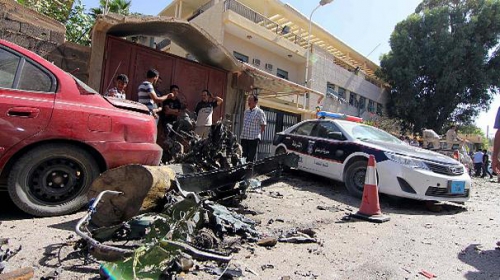
S’il est peu probable qu’un consensus se dégage à l’ONU pour un tel scénario - la Russie et la Chine ne permettront pas la répétition de la guerre franco-britannique d’octobre 2011 -, la montée en puissance de l’ « Etat islamique » en Libye plaident pourtant pour une riposte militaire. Mais contre qui intervenir et comment ? « Il y a des cellules dormantes dans chaque ville, qui ont des liaisons directes avec le chef de Dae’ch Abou Bakr al-Baghdadi », a averti cette semaine un porte-parole militaire, le colonel Ahmed al-Mesmari. Les experts estiment très difficile pour une coalition internationale de se fixer des cibles à bombarder par les airs sans s'appuyer sur un travail de renseignement très approfondi, en raison de la multitude des factions qui ne partagent pas forcément la même idéologie que Dae’ch ou Ansar al-Charia. Une intervention terrestre devrait par contre mobiliser des dizaines de milliers d'hommes et aurait peu de chances de réussir. Les cas afghan et irakien en sont le parfait exemple.
POUR UNE SOLUTION POLITIQUE
Une intervention militaire ferait de la Libye une terre de jihad où afflueraient, encore plus qu’aujourd’hui, les activistes des pays du Maghreb, d'Afrique, mais aussi de Syrie et d'Irak - bastions de l’ « Etat islamique ». Si l'opération se résume exclusivement à des bombardements aériens, elle ne fera que radicaliser la population, en raison notamment des dégâts collatéraux et des victimes civiles qu'une telle opération engendrera fatalement. Par conséquent, la solution est politique et certainement pas militaire ! Il s’agira de chercher à rapprocher les différentes factions rivales afin de construire une armée libyenne nationale pour s’opposer à l’extension territoriale et politique de Dae’ch. Cette voie prendra du temps…
Dans ce contexte, le représentant spécial des Nations unies, Bernardino Léon, tente depuis des mois de trouver un terrain d’accord politique pour la formation d’un gouvernement d’union nationale. Il faut soutenir ses efforts… en lui suggérant, peut-être de réintroduire le fils de Kadhafi - Saïf al-Islam - qui jouit toujours d’une autorité certaine auprès des partisans de son père dont l’influence et le souvenir inspirent toujours plusieurs des factions armées toujours actives.
Richard Labévière, Rédacteur en chef de prochetmoyen-orient.ch, 1er mars 2015
[1] Jean Ping (né le 24 novembre 1942 à Omboué au Gabon), est un diplomate et homme politique gabonais. Il est élu président de la commission de l’Union africaine le 1er février 2008 au premier tour de scrutin1. Il était ministre d’État, ministre des Affaires étrangères, de la Coopération et de la Francophonie de la république du Gabon du 25 janvier 1999 au 6 février 2008.
[2] Editions Michalon, avril 2014.





 del.icio.us
del.icio.us
 Digg
Digg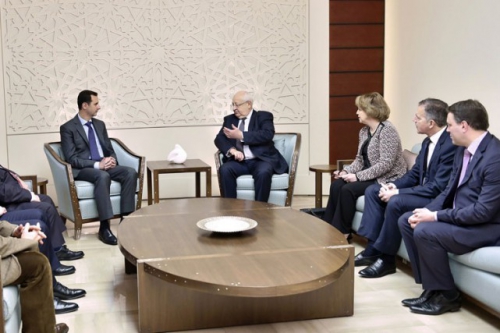
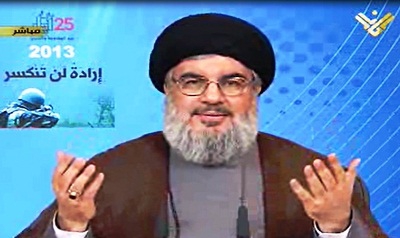 Nasrallah himself stated: “I want to ask the Christians before the Muslims: You are seeing what is taking place in Syria. I am not causing sectarian evocations. Let no one say that Sayyed is doing so. Not at all! Where are your churches? Where are your patriarchs? Where are your nuns? Where are your crosses? Where are the statues of Mary (pbuh)? Where are your sanctities? Where are all of these? What has the world done for them? What did the world do for them previously in Iraq? Aren’t these groups causing all of this in all the regions?”
Nasrallah himself stated: “I want to ask the Christians before the Muslims: You are seeing what is taking place in Syria. I am not causing sectarian evocations. Let no one say that Sayyed is doing so. Not at all! Where are your churches? Where are your patriarchs? Where are your nuns? Where are your crosses? Where are the statues of Mary (pbuh)? Where are your sanctities? Where are all of these? What has the world done for them? What did the world do for them previously in Iraq? Aren’t these groups causing all of this in all the regions?”

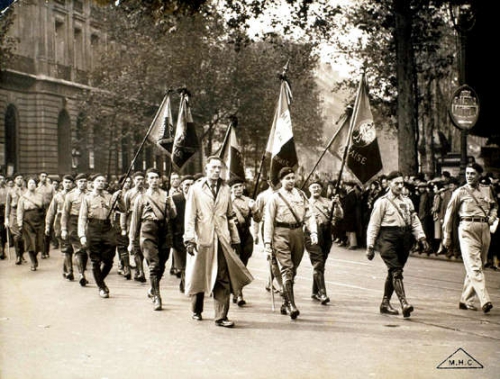
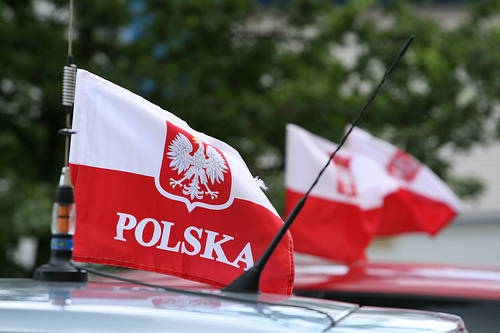

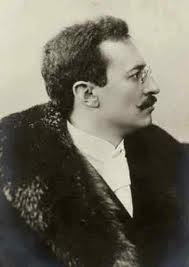 Hedin’s (1891) second visit to Iran was as a member of the Swedish King Oscar II’s diplomatic mission to the Persian king Nasr-ed-din Shah in 1890. After the formal assignment Hedin followed the Shah to the Elburz Mountains and made a successful attempt to ascend Mount Damāvand – a snow capped volcano reaching 5,671 meters above sea level and also the highest mountain in the Middle East. This achievement constituted the basis for Hedin’s (1892a) doctoral dissertation two years later. Before returning to Sweden Hedin set off on a reconnaissance trip from Tehran towards Central Asia that took him all the way to Kashgar in westernmost China. Along this route he got a first glimpse of Iran’s central salt desert, the Dasht-e Kavir (Hedin 1892b). The following decade Hedin conducted two extended scientific expeditions focusing on the deserts of Xinjiang and the high plateau of Tibet.
Hedin’s (1891) second visit to Iran was as a member of the Swedish King Oscar II’s diplomatic mission to the Persian king Nasr-ed-din Shah in 1890. After the formal assignment Hedin followed the Shah to the Elburz Mountains and made a successful attempt to ascend Mount Damāvand – a snow capped volcano reaching 5,671 meters above sea level and also the highest mountain in the Middle East. This achievement constituted the basis for Hedin’s (1892a) doctoral dissertation two years later. Before returning to Sweden Hedin set off on a reconnaissance trip from Tehran towards Central Asia that took him all the way to Kashgar in westernmost China. Along this route he got a first glimpse of Iran’s central salt desert, the Dasht-e Kavir (Hedin 1892b). The following decade Hedin conducted two extended scientific expeditions focusing on the deserts of Xinjiang and the high plateau of Tibet.
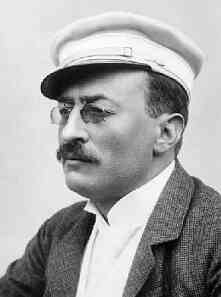 Sven Hedin est né le dimanche 19 février 1865 au sein d’une famille bien en vue de la bourgeoisie de Stockholm, descendant de lignées paysannes du centre de la Suède mais qui comptait aussi, parmi ses ancêtres, un rabbin de Francfort-sur-l’Oder. Le père de Sven Hedin était un architecte très actif, qui a connu le succès tout au long de sa carrière. La famille « vivait simplement, sans prétention, en ses foyers régnaient calme et tranquillité, confort et bonheur », écrira plus tard son célèbre fils.
Sven Hedin est né le dimanche 19 février 1865 au sein d’une famille bien en vue de la bourgeoisie de Stockholm, descendant de lignées paysannes du centre de la Suède mais qui comptait aussi, parmi ses ancêtres, un rabbin de Francfort-sur-l’Oder. Le père de Sven Hedin était un architecte très actif, qui a connu le succès tout au long de sa carrière. La famille « vivait simplement, sans prétention, en ses foyers régnaient calme et tranquillité, confort et bonheur », écrira plus tard son célèbre fils. 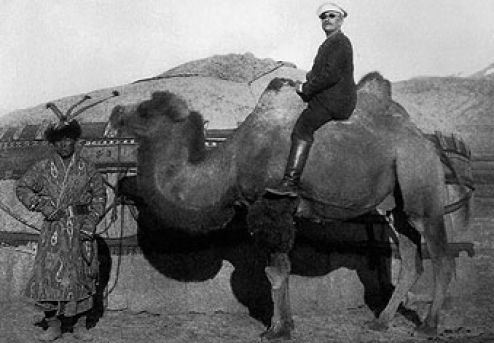
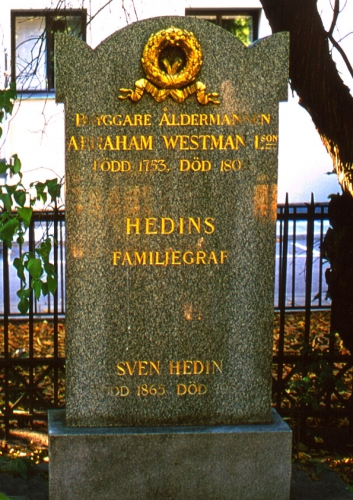 Hedin était germanophile et ne s’en est jamais caché. Cette sympathie pour le Reich, il la conservera même après l’effondrement dans l’horreur que l’Allemagne a connu en 1945. On lui reprochera cette attitude, aussi en Suède et, évidemment, dans les pays victorieux. La rééducation, en Allemagne, fera que ce germanophile impénitent sera également ostracisé, en dépit de ses origines partiellement juives et de son esprit universel. Cet ostracisme durera longtemps, perdure même jusqu’à nos jours. Pourtant Hedin, qui avait la plume si facile, s’est justifié avec brio, en écrivant « Ohne Auftrag in Berlin » (« A Berlin sans ordre de mission »). Ses démonstrations n’ont servi à rien. Sven Hedin meurt, isolé, à Stockholm le 26 novembre 1952.
Hedin était germanophile et ne s’en est jamais caché. Cette sympathie pour le Reich, il la conservera même après l’effondrement dans l’horreur que l’Allemagne a connu en 1945. On lui reprochera cette attitude, aussi en Suède et, évidemment, dans les pays victorieux. La rééducation, en Allemagne, fera que ce germanophile impénitent sera également ostracisé, en dépit de ses origines partiellement juives et de son esprit universel. Cet ostracisme durera longtemps, perdure même jusqu’à nos jours. Pourtant Hedin, qui avait la plume si facile, s’est justifié avec brio, en écrivant « Ohne Auftrag in Berlin » (« A Berlin sans ordre de mission »). Ses démonstrations n’ont servi à rien. Sven Hedin meurt, isolé, à Stockholm le 26 novembre 1952.
 Pero toda decisión tiene consecuencias. Nuestros “nuevos derechos” individualistas, por desgracia, no conllevaron responsabilidades, y los pilares de nuestro futuro se resienten dramáticamente. Crisis demográfica irremediable (según el INE, España perderá más de 5 millones de habitantes en cuarenta años), destrucción del colchón familia (imparable reducción del número de matrimonios, más de la mitad en treinta años), endeudamiento masivo (la deuda sobre el PIB llegó al 96% en 2014, el doble que hace diez años), tasas de paro, especialmente juvenil, convertidas en estructurales (sobre el 20% de la población, el doble que hace un lustro), empeoramiento de las condiciones de trabajo (devaluación salarial masiva por medio de nuevos contratos más precarios, productividad siguiendo el modelo chino), sistema educativo obsoleto (desde el Informe Pisa a los índices de empleabilidad de los universitarios), crecimiento imparable de la pobreza (21,8% según Foessa); así como el afianzamiento de supuestas peculiaridades antropológicas, como que solo el 16% de los españoles defendería su país en caso de invasión (CIS), que seamos el segundo país más ruidoso del mundo (OMS), el primer país en consumo juvenil de drogas de Europa (Observatorio Europeo de las Drogas), de los primeros en consumo televisivo (Outbrain) y de los más bajos en lectura de libros (Gremio de editores), uno de los países más dependientes de fuentes de energía foráneas (Eurostat), con más agresión urbanística (casi el 50% del total de la costa mediterránea), con mayores tasas de violencia contra la mujer o con el aire más contaminado (95% de los españoles según el Informe de calidad del aire). Pese a ciertos actos altruistas o pulsiones solidarias, pareciese que nos diera igual nuestro país; sálvese quien pueda.
Pero toda decisión tiene consecuencias. Nuestros “nuevos derechos” individualistas, por desgracia, no conllevaron responsabilidades, y los pilares de nuestro futuro se resienten dramáticamente. Crisis demográfica irremediable (según el INE, España perderá más de 5 millones de habitantes en cuarenta años), destrucción del colchón familia (imparable reducción del número de matrimonios, más de la mitad en treinta años), endeudamiento masivo (la deuda sobre el PIB llegó al 96% en 2014, el doble que hace diez años), tasas de paro, especialmente juvenil, convertidas en estructurales (sobre el 20% de la población, el doble que hace un lustro), empeoramiento de las condiciones de trabajo (devaluación salarial masiva por medio de nuevos contratos más precarios, productividad siguiendo el modelo chino), sistema educativo obsoleto (desde el Informe Pisa a los índices de empleabilidad de los universitarios), crecimiento imparable de la pobreza (21,8% según Foessa); así como el afianzamiento de supuestas peculiaridades antropológicas, como que solo el 16% de los españoles defendería su país en caso de invasión (CIS), que seamos el segundo país más ruidoso del mundo (OMS), el primer país en consumo juvenil de drogas de Europa (Observatorio Europeo de las Drogas), de los primeros en consumo televisivo (Outbrain) y de los más bajos en lectura de libros (Gremio de editores), uno de los países más dependientes de fuentes de energía foráneas (Eurostat), con más agresión urbanística (casi el 50% del total de la costa mediterránea), con mayores tasas de violencia contra la mujer o con el aire más contaminado (95% de los españoles según el Informe de calidad del aire). Pese a ciertos actos altruistas o pulsiones solidarias, pareciese que nos diera igual nuestro país; sálvese quien pueda.
 Erling Jirle, der Vorsitzende der Taxonomie-Kommission der
Erling Jirle, der Vorsitzende der Taxonomie-Kommission der 